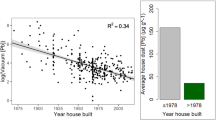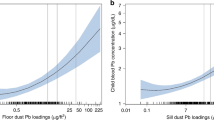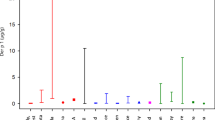Abstract
This paper reports findings from a screening study conducted to examine potential lead (Pb) exposures in residents of a Mexican village where Pb oxide continues to be used in ceramic pottery production. Extremely high Pb concentrations were measured in personal and indoor air samples, household surface dust samples, and household soil samples. Personal air Pb concentrations for workers performing pottery firing and glazing were up to 454 μg/m 3. Results from indoor air samples indicate that airborne Pb concentrations were lower during nonglazing period compared to the glazing period. Soil Pb concentrations measured in 17 homes ranged from 0.39 to 19.8 mg/g. Dust Pb loading on surfaces of household items, hands, and clothes of a worker ranged from 172 to 33 060 μg/ft 2. Pb content as high as 2.4 μg/g was found in a bean stew cooked in a pot made in the village. Based on these Pb concentrations measured in multiple media and data adapted for exposure contact rates, we have made rough estimates of Pb exposures via inhalation, soil/dust ingestion, and food ingestion. Estimated total daily Pb intake, on average, is 4.0 mg for adults and 3.4 mg for children living in the village. In the total daily intake, a greatest fraction may be contributed by food ingestion and another significant fraction may come from soil/dust ingestion for the children. Although the sample size is small, these measurements indicate a very significant public health problem for the village residents and a large number of other similar communities in Mexico. (It was estimated that there are approximately 1.5 million glaze potters.) The Pb exposure is implicated in a number of pervasive health problems in the region, and is the cause for national and international attention. Several recommended solutions to this problem range from personal protection and behavioral changes to introduction of alternative glazes.
This is a preview of subscription content, access via your institution
Access options
Subscribe to this journal
Receive 6 print issues and online access
$259.00 per year
only $43.17 per issue
Buy this article
- Purchase on Springer Link
- Instant access to full article PDF
Prices may be subject to local taxes which are calculated during checkout
Similar content being viewed by others
Author information
Authors and Affiliations
Corresponding author
Rights and permissions
About this article
Cite this article
HIBBERT, R., BAI, Z., NAVIA, J. et al. High lead exposures resulting from pottery production in a village in Michoacán State, Mexico. J Expo Sci Environ Epidemiol 9, 343–351 (1999). https://doi.org/10.1038/sj.jea.7500035
Revised:
Accepted:
Published:
Issue Date:
DOI: https://doi.org/10.1038/sj.jea.7500035
Keywords
This article is cited by
-
Assessment of potters’ occupational exposure to lead and associated risk factors in Maragogipinho, Brazil: preliminary results
International Archives of Occupational and Environmental Health (2021)
-
A qualitative analysis of environmental policy and children's health in Mexico
Environmental Health (2010)



